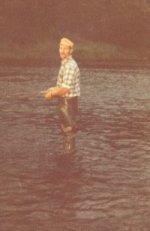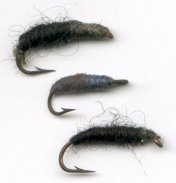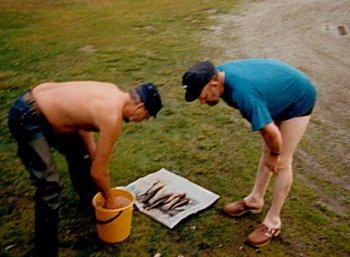My Ammerån - how it started - the seventies <in Swedish>

Start | The
beginning | How it
continued | And
continued | And then?
Moan | Blomgrundet
| Danielholmen | Baracken | Vårv
| Skattlandsforsen | Färsån
 One
of my earliest memories associated with Ammerån is an occasion when my
father is getting ready to go fishing, and puts on a baseball cap back
to front on his head. I asked why he did this, and he said it was to
scare the fish so they would be easier to catch. It must have been
during the early seventies and I was still too young to follow. My
father grew up in Färsån, a village located in the valley of Ammerån,
between Överammer and Ammer. In the middle of the village Färsån, the
rill Färsån has its outlet in to Ammerån. My dad took over his birth
place in the early seventies and we spent every weekend, and much of
the summers, there throughout my childhood. You can say that I have
fishing in my blood, because my father always fished, and fishing were
part of everyday life.
One
of my earliest memories associated with Ammerån is an occasion when my
father is getting ready to go fishing, and puts on a baseball cap back
to front on his head. I asked why he did this, and he said it was to
scare the fish so they would be easier to catch. It must have been
during the early seventies and I was still too young to follow. My
father grew up in Färsån, a village located in the valley of Ammerån,
between Överammer and Ammer. In the middle of the village Färsån, the
rill Färsån has its outlet in to Ammerån. My dad took over his birth
place in the early seventies and we spent every weekend, and much of
the summers, there throughout my childhood. You can say that I have
fishing in my blood, because my father always fished, and fishing were
part of everyday life.
Fishing was at that time not only for pleasure, but also constituted a
not insignificant part of everyday dinners. It was quite natural to
take home the fish you caught - fish below the minimum measurement, 25
cm at that time, was however returned. The pressure on the fish
habitat produced by fishermen was significantly lower in those days,
when fishing tourism was not very developed, and it was preferably
locals who were fishing in the river. Ammerån was at that time
threatened to be exploited - a threat that remained until the early
nineties when the government finally decided to protect the river from
hydroelectric companies devastation. The river was marked by floating
operations which subsided only in the early seventies, and it took
several years before the restoration of the grounds were made. Still,
there were plenty of grayling in the river. My father, who had fished
in the river since the forties, however told that fishing became worse
when floating operations slowed down. Probably, the timber floating
drug with it a lot of extra food for the fish, and one sure dreamed
that it would have been possible to attend any of the fishing trips of
the fifties and sixties my father told me about
.
 One story he likes to tell is when he, an evening in July sometime in
the sixties, crossed Ammerån where the timber had congested, at
Baracken for fishing on the south side. The fishing was good, and soon
he had plenty of grayling in his knapsack. Suddenly the timber broke
loose and the temporary bridge over the river was suddenly gone. The
water was too high, so it was not possible to wade across, so my
father had no other way than to go fishing his way up to Överammer to
cross the river again and to arrange a ride home. The fishing
continued to be good, so when he finally, in the early morning,
reached Överammer, not only his wis knapsack full of big grayling, but
also other areas of the clothing and equipment had to work as a
temporary fish storage. In addition to several fine dinings in the
freezer, family and friends also got a share. The most striking was
that he was all alone by the river that night - not a man in sight,
either on the north or south side - something that was not unusual at
the time, but that do not happen today.
One story he likes to tell is when he, an evening in July sometime in
the sixties, crossed Ammerån where the timber had congested, at
Baracken for fishing on the south side. The fishing was good, and soon
he had plenty of grayling in his knapsack. Suddenly the timber broke
loose and the temporary bridge over the river was suddenly gone. The
water was too high, so it was not possible to wade across, so my
father had no other way than to go fishing his way up to Överammer to
cross the river again and to arrange a ride home. The fishing
continued to be good, so when he finally, in the early morning,
reached Överammer, not only his wis knapsack full of big grayling, but
also other areas of the clothing and equipment had to work as a
temporary fish storage. In addition to several fine dinings in the
freezer, family and friends also got a share. The most striking was
that he was all alone by the river that night - not a man in sight,
either on the north or south side - something that was not unusual at
the time, but that do not happen today.
I myself had to wait until the mid-seventies before I was big enough
to fish Ammerån. I had already fished, but then it was easier fishing
such as perch in the Köttsjön - fishing in Ammerån demands more of the
fisherman in the form of stamina and patience. Initially I fished with
spinners, but in the end of the seventies I move more and more to fly
fishing. My first fly rod was an ABU fiberglass rod from the late
sixties.
 I
learned to fish, primarily from my father, but also my uncle Ruben has
had a great impact on my fishing. He lived in Dalarna, but come "home"
to Färsån a week or two every summer, and then it was fishing-time
almost every night. Depending on the water level, my father and uncle
was fishing with worm or fly, while I fished with fly or spin - worm
fishing is an art that is difficult to learn, and you should be a
little bigger before trying it out. Worm fishing is what works best
early in the season in Ammerån - a truth that stands even today. The
experienced "old men", with their long rods seeking the hollows in and
around the rapids in Ammerån, on the high tide in early June, can have
numerous grayling when even the most experianced fly fisherman gets
nothing. The flies that was used at the time were mainly simple
nymphs, and the wet fly Jungle Cock in black, purple or silver. The
seasoned fly casters had three flies on his leader, but as a beginner
you had to start with two. At the far end on the leader you placed a
black nymph - as it still does on my fly casts for Ammerån - and as
hanger quite often a Jungle Cock silver. The number of fish, as
stated, was good - although it was quite rare to get the really big
grayling. Obviously it was my father who accounted for most of the
catch, but even I managed to fool the occasional grayling, and with
the catches the interest increased - an interest that still thrives.
I
learned to fish, primarily from my father, but also my uncle Ruben has
had a great impact on my fishing. He lived in Dalarna, but come "home"
to Färsån a week or two every summer, and then it was fishing-time
almost every night. Depending on the water level, my father and uncle
was fishing with worm or fly, while I fished with fly or spin - worm
fishing is an art that is difficult to learn, and you should be a
little bigger before trying it out. Worm fishing is what works best
early in the season in Ammerån - a truth that stands even today. The
experienced "old men", with their long rods seeking the hollows in and
around the rapids in Ammerån, on the high tide in early June, can have
numerous grayling when even the most experianced fly fisherman gets
nothing. The flies that was used at the time were mainly simple
nymphs, and the wet fly Jungle Cock in black, purple or silver. The
seasoned fly casters had three flies on his leader, but as a beginner
you had to start with two. At the far end on the leader you placed a
black nymph - as it still does on my fly casts for Ammerån - and as
hanger quite often a Jungle Cock silver. The number of fish, as
stated, was good - although it was quite rare to get the really big
grayling. Obviously it was my father who accounted for most of the
catch, but even I managed to fool the occasional grayling, and with
the catches the interest increased - an interest that still thrives.
Continue to the
eighties>>